Subjects:
- Electronic mirror adjustment
- Adjust vertically
- Adjust horizontally
- Mirror adjustment with memory function
Electronic mirror adjustment:
Two electric motors are mounted in the mirror housing of a car with electrically operated exterior mirrors. One electric motor is to move the mirror glass up or down. This is the vertical movement. The other electric motor is for the horizontal movement; left and right.
In order to be able to operate the exterior mirrors, a button is incorporated in the interior of the car. This can be, for example, in the dashboard, the center console or the door.
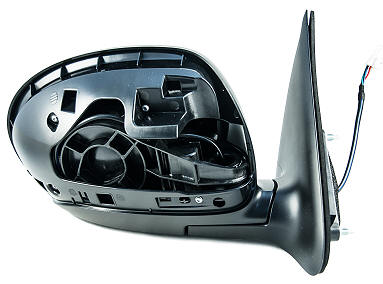
The signals from the switch reach the control unit (the ECU). This is usually the comfort control unit or the door control unit. These control devices are often connected to the CAN bus. When the control unit receives a signal from the switch, this switch (on older vehicles) or the ECU (on newer vehicles) will be activated by means of a H-bridge control the electric motors to move the mirror glass.

The waterfall diagram shows that the power supply and ground are connected to pin 7 and pin 11. The CAN-high and CAN-low are connected to the ECU on pins 8 and 9.
The switches for the vertical movements are connected to pins 1 and 2. Pin 3 is the power supply for these two switches. The same applies to pin 6, which is the power supply for the switches for the horizontal movements on pins 4 and 5 of the ECU.
The electric motors are connected to pins 8 and 10. The left electric motor (pin 8) is for the vertical movements. The right one (pin 10) is for the horizontal movements. Pin 9 has a wire that is connected to both electric motors. Depending on the situation, the ECU can switch on both a plus and a ground here. How this works is described in the following paragraphs.
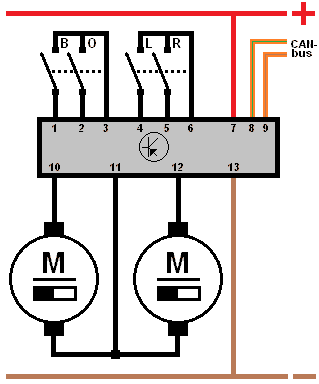
Adjust vertically:
This explanation is about the two images below.
When adjusting the mirror glass upwards, the left electric motor is controlled by switch B on pin 1. The control unit then switches a supply voltage to pin 8, which is connected to the electric motor with a wire. Ground is switched on pin 9. The left electric motor will start to rotate until switch B is interrupted again.
When adjusting downwards, switch O will close. The power supply is now applied to pin 9 of the control unit and pin 8 becomes ground. Because the plus and the mass are reversed on the electric motor, the electric motor will rotate in the opposite direction (i.e. downwards instead of upwards). This can be seen in the images below.
When the electric motor for the vertical adjustment is running, the electric motor for the horizontal adjustment must be stationary. Both connections of the electric motor that must remain stationary are short-circuited by pin 9 to ground or positive. A supply voltage or ground can be switched separately from each other on pins 8, 9 and 10.
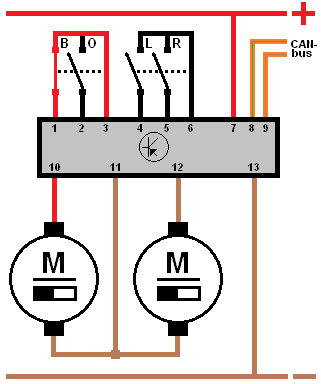
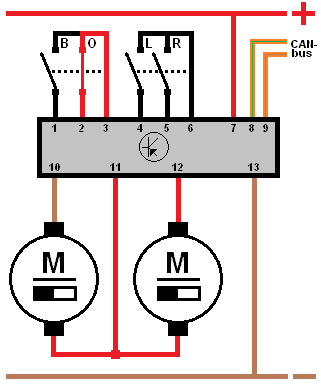
Changing the plus and minus to change the direction of rotation of the electric motor is possible with a so-called H-bridge. This circuit of four transistors or FETs is installed in the ECU. The ECU controls the correct transistors in pairs (one for plus and one for ground) to determine the direction of current to the electric motor.
Adjust horizontally:
This explanation is about the two images below.
When adjusting to the left, switch L will close. The right electric motor receives a supply voltage via pin 10 on the control unit. The ground goes through pin 9.
Because the left electric motor (for the vertical adjustment) is now not allowed to rotate, it is also connected to ground at pin 8. The left electric motor is therefore short-circuited to ground. The right electric motor rotates at a constant speed until switch L is no longer actuated.
When adjusting to the right, the supply voltage and ground on the right electric motor are reversed again. The electric motor will now turn the other way.
Now no ground is applied to pin 8 of the left electric motor, but the supply voltage. Otherwise it would also run. Now that both sides are switched to plus, the electric motor is stationary.
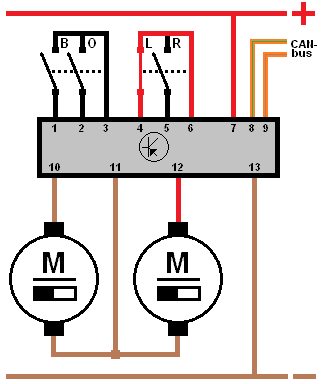
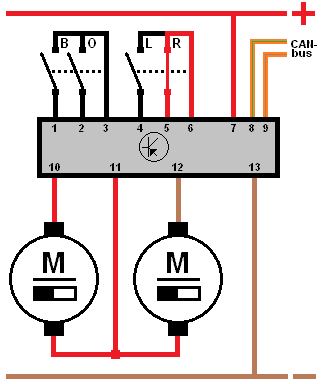
Mirror adjustment with memory function:
Modern vehicles have a mirror adjustment with memory function. The ECU controls actuators until they have reached the desired position. The position recognition takes place by means of potentiometers. More information can be found on the page about the potentiometer.
In the diagram we see the potentiometers G791 and G792. The potentiometers receive a voltage of 5 volts and ground from the ECU. The signals are sent to pins 1 and 9 of connector T16a.
The ECU recognizes the position of the actuating motors V17 and V149 by reading the signal voltages from the potentiometers. With a set value in the memory, the ECU continues to control the actuating motors V17 and V149 until the signal voltage is equal to the value stored in the memory. Example:
- The car is unlocked with key A;
- The stored value of V17 is 3,6 volts;
- The measured value of V17 is 2,9 volts;
- The ECU controls electric motor V17 until the potentiometer gives a signal voltage of 3,6 volts;
- When the car is unlocked with key B, with the stored value 2,9 volts, the same process takes place to reach the stored value.
The operation, versions and possible malfunctions are shown on the page Potentiometer treated.
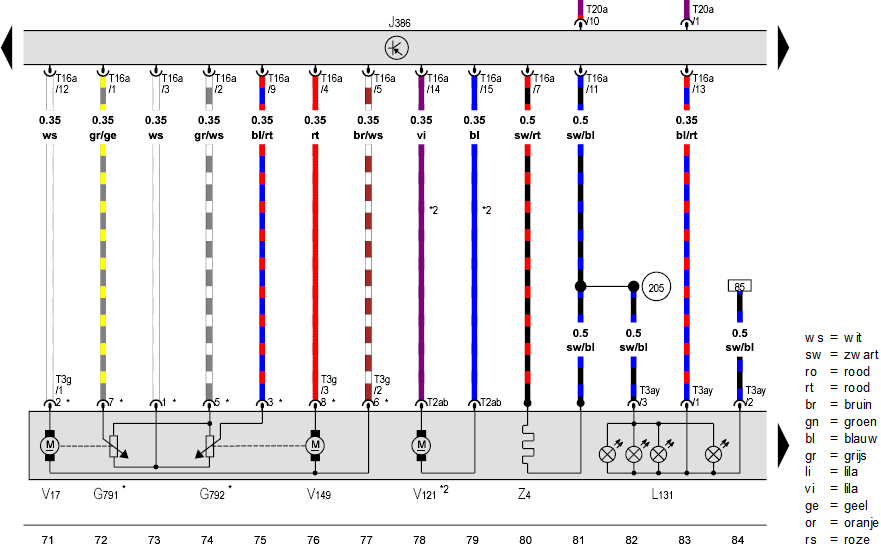
Related page:
